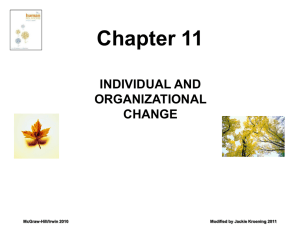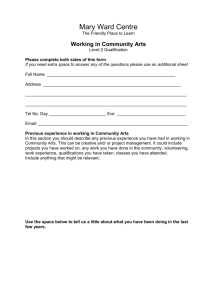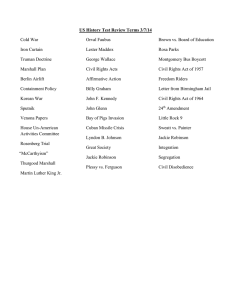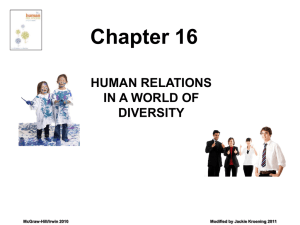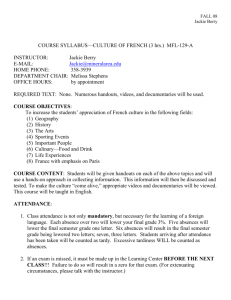Chap014 - LifeTour
advertisement
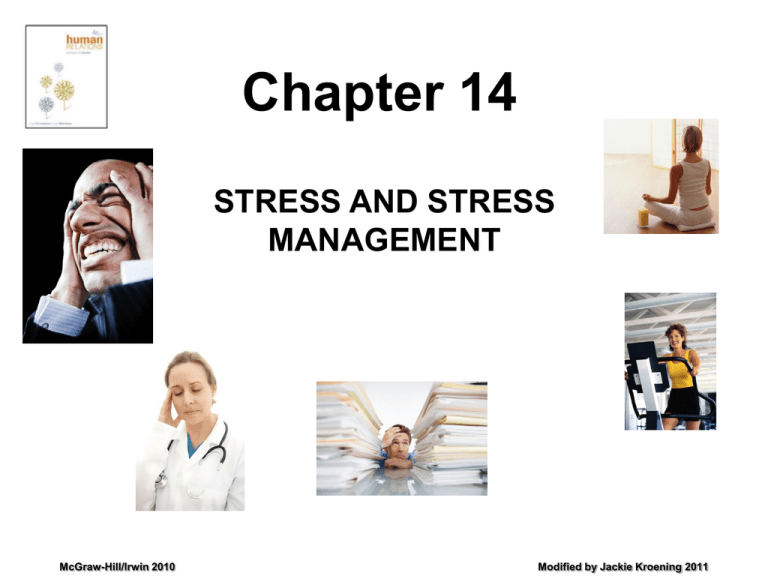
Chapter 14 STRESS AND STRESS MANAGEMENT McGraw-Hill/Irwin 2010 Modified by Jackie Kroening 2011 Causes of Stress * Stress is any reaction or response made by the body to a new situation. Two kinds of stress: * Eustress is a positive, pleasant, and desirable stress. Example: wining a race. Distress is negative stress. Stressor is a situation or an event that causes the body to react. Parts taken from Human Relations 4ed Modified by Jackie Kroening 2011 Causes of Stress Life changes and daily hassles * Major life changes such as divorce increase daily hassles, causing stress. Example is “During the past year, you got married, got a promotion, and moved into a bigger house.” Daily hassles such as getting stuck in traffic or misplacing your keys cause stress in your life. Even if stress is due to a pleasant change, daily hassles can occur. Parts taken from Human Relations 4ed Modified by Jackie Kroening 2011 Causes of Stress Chronic stressors Inescapable day-to-day situations or conditions that cause stress. More stressful than daily hassles. Not as stressful as a major life change. Examples include poverty, abuse, longterm health problems, and racism. Parts taken from Human Relations 4ed Modified by Jackie Kroening 2011 Sources of Stress External stressors Stressors from outside sources that causes pain or discomfort, frustration, or conflict. Frustration is the feeling people get when their goals are blocked. * Inner conflict is the pressure felt when forced to make a choice. The three types of inner conflict are approachapproach, approach-avoid, and avoid-avoid. Parts taken from Human Relations 4ed Modified by Jackie Kroening 2011 Sources of Stress * Approach-approach conflict – Feeling of conflict one gets when torn between two desirable goals. Approach-avoid conflict – Occurs when one is drawn towards and away from something at the same time. * Avoid-avoid conflict – Occurs when one is torn between two undesirable options. Parts taken from Human Relations 4ed Modified by Jackie Kroening 2011 Sources of Stress Internal stressors One’s perceptions or interpretations of a stressor as well as personality factors. Perceptions differ because of: * Cognitive appraisal: Your “thinking evaluation” of an event or a situation. * The unnecessary stress of irrational beliefs: An irrational belief system or, at worst, turning an irrational belief into an imagined catastrophe. The stress of irrational beliefs can be reduced by the “rational emotive therapy.” Parts taken from Human Relations 4ed Modified by Jackie Kroening 2011 Sources of Stress Ellis’s ABC Approach to stress Parts taken from Human Relations 4ed Modified by Jackie Kroening 2011 Type A and Type B Personality Behavior Type A and Type B personalities are associated with personality factors. * Type A personality is characterized by impatience, hostility, perfectionism, and a sense of time urgency. * Type B is characterized by flexibility, the ability to relax and delegate work, and a minimal sense of time urgency. Most top level executives are likely to be Type B people. Parts taken from Human Relations 4ed Modified by Jackie Kroening 2011 Type A and Type B Personality Behavior Someone with a different kind of personality than type A or type B: The survivor personality type manage things well even if the stressors and problems are impossible to overcome. The hardy or resilient personality see *1. challenges, have a sense of 2. commitment, and a feeling of being in 3. control. (the three C’s) Parts taken from Human Relations 4ed Modified by Jackie Kroening 2011 The Physical Effects of Stress General Adaptation Syndrome (GAS): When confronted with stress, the body responds with an activation of the sympathetic nervous system – Fight-or-flight response. * When the fight-or-flight response is activated, you enter the first stage of GAS – Alarm. The second stage is adaptation where one adapts to the stressor and can usually return to normal. * The third stage is exhaustion where one ends up using all the physical resources. Parts taken from Human Relations 4ed Modified by Jackie Kroening 2011 The Physical Effects of Stress The immune system serves three basic functions: Recognizing foreign cells and attacking them. Developing antibodies to recognize foreign invaders in the future. Sending white blood cells and other helper cells to the location of an injury or infection to speed healing. Chronic stress can actually weaken your immune system and fall victim to an illness that you would normally fight off with ease. Parts taken from Human Relations 4ed Modified by Jackie Kroening 2011 The Cost of Stress in the Workplace Job burnout is the physical and emotional exhaustion resulting from long-term stress or frustration in one’s workplace. It leads to lower productivity, lost days of work, worker’s compensation claims, and lawsuits among others. Parts taken from Human Relations 4ed Modified by Jackie Kroening 2011 The Cost of Stress in the Workplace Health effects on employees are headaches, back pain, exhaustion, anxiety, anger, insomnia, and digestive upsets. Other effects include accidents on the job, excessive eating or smoking, anger outbursts, and alcohol/drug abuse. Employees are seeking help for stress through employee programs. Parts taken from Human Relations 4ed Modified by Jackie Kroening 2011 The Cost of Stress in the Workplace Causes of employee stress Parts taken from Human Relations 4ed Stress from management. Having no say in decisions. Too much/little structure. Racism and sexism. Frustrating company policies. Low pay. Stressful relationships with supervisors/peers. Boredom. Work overload; too much responsibility. No promotions. Modified by Jackie Kroening 2011 The Cost of Stress in the Workplace Stress affects self-esteem. It makes one overwhelmed. It makes people less productive and less successful, which lowers self-esteem. It impacts all areas of people’s lives. Parts taken from Human Relations 4ed Modified by Jackie Kroening 2011 Strategies for Success Discard irrational beliefs: 1. 2. 3. 4. Evaluate the consequences of the belief. Identify your belief system. Dispute the self-defeating belief. Practice effective ways of thinking. Parts taken from Human Relations 4ed Modified by Jackie Kroening 2011 Strategies for Success Change your behaviors to reduce stress: 1. 2. 3. 4. 5. Take charge of your life. Use humor. Compare yourself with others. Take advantage of stress. Learn to live with unavoidable stress. Parts taken from Human Relations 4ed Modified by Jackie Kroening 2011 Strategies for Success Take care of yourself: 1. 2. 3. 4. 5. 6. 7. Parts taken from Human Relations 4ed Use relaxation techniques. Increase your fitness: Exercise, eat well, and reduce/quit smoking and drinking. Make time for rest and leisure. Get social support. Try to reduce stress in the workplace. Manage your time. Stop procrastinating. Modified by Jackie Kroening 2011
